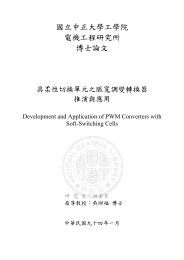Syntax of the Bi Comparative Construction in Mandarin Chinese
Syntax of the Bi Comparative Construction in Mandarin Chinese
Syntax of the Bi Comparative Construction in Mandarin Chinese
Create successful ePaper yourself
Turn your PDF publications into a flip-book with our unique Google optimized e-Paper software.
<strong>Syntax</strong> <strong>of</strong> <strong>the</strong> <strong>Bi</strong> <strong>Comparative</strong> <strong>Construction</strong> <strong>in</strong> Mandar<strong>in</strong> Ch<strong>in</strong>ese<br />
element is dealt with as a/<strong>the</strong> “topic” <strong>of</strong> discourse, <strong>the</strong> “given” <strong>in</strong>formation. In <strong>the</strong><br />
literature <strong>the</strong> term “topicalization” <strong>of</strong>ten <strong>in</strong>dicates <strong>the</strong> process that here we refer to as<br />
“focalization” (Focus): <strong>the</strong> s<strong>in</strong>gl<strong>in</strong>g out <strong>of</strong> an element <strong>of</strong> <strong>the</strong> clause as <strong>the</strong> “new” or<br />
“contrastive” <strong>in</strong>formation. Based on Belletti’s (2004) analysis, <strong>the</strong> given <strong>in</strong>formational<br />
topic <strong>of</strong> (120) is wo, thus is topicalized to <strong>the</strong> TopP, while <strong>the</strong> new/constructive<br />
<strong>in</strong>formation topic is j<strong>in</strong>tian, is <strong>in</strong> <strong>the</strong> FocusP. The movements and <strong>the</strong> land<strong>in</strong>g sites are<br />
more legitimate with Belletti’s (2004) analysis. Also, <strong>in</strong> <strong>the</strong> proposed syntactic<br />
structure <strong>of</strong> BCC, I adopt Rizzi’s (1997) skeleton, <strong>in</strong> which he decompose CP <strong>in</strong>to <strong>the</strong><br />
follow<strong>in</strong>g projections: ForceP > TopicP* > FocusP > TopicP* > F<strong>in</strong>iteP > IP so as to<br />
give a plausible explanation on <strong>the</strong> surface word order <strong>of</strong> BCC.<br />
Last but not least, this geng-headed structure also undergoes a <strong>Comparative</strong><br />
Deletion (CD) on CP2 <strong>in</strong> <strong>the</strong> PF; <strong>the</strong>refore, <strong>in</strong> (121) xiang ni <strong>in</strong> vP2 is not spelled out<br />
<strong>in</strong> PF. The issue <strong>of</strong> CD will be discussed more <strong>in</strong> <strong>the</strong> next section.<br />
3.4.3 <strong>Comparative</strong> Deletion<br />
Under <strong>the</strong> previous hypo<strong>the</strong>sis that a CC is composed by at least two clauses, it is<br />
accepted that BCC <strong>in</strong>volve some ellipsis operation (Bresnan 1975, Hong 1981, Napoli<br />
1983, Liu 1996, 1999, Kennedy 1999, Lechner 2001, Hs<strong>in</strong>g 2003, Chao 2005 and so<br />
on). By Napoli’s (1983) def<strong>in</strong>ition, <strong>Comparative</strong> Deletion (CD) is an obligatory rule<br />
that deletes a phrase <strong>in</strong> <strong>the</strong> subord<strong>in</strong>ate clause under identity to <strong>the</strong> quantified phrase<br />
<strong>in</strong> <strong>the</strong> higher clause, while <strong>Comparative</strong> Ellipsis (CE) is an optional rule that delete<br />
elements from <strong>the</strong> subord<strong>in</strong>ate clause under identity with elements <strong>in</strong> <strong>the</strong> ma<strong>in</strong> clause.<br />
In (122), wo is obligatorily deleted by CD, while it is optional to delete chi without<br />
chang<strong>in</strong>g <strong>the</strong> mean<strong>in</strong>g <strong>of</strong> <strong>the</strong> sentences. Yet, this CD analysis helps to make <strong>the</strong><br />
ambiguous sentence (123) clear <strong>in</strong> (123b) and (123c). Sentence (123b) are comparison<br />
<strong>of</strong> two clauses with <strong>the</strong> same gradable predicate xiang ta, thus <strong>the</strong> one <strong>in</strong> <strong>the</strong><br />
73<br />
中正大學 e-Thesys (94 學年度)





